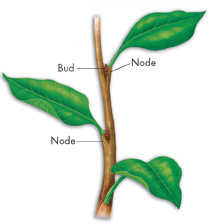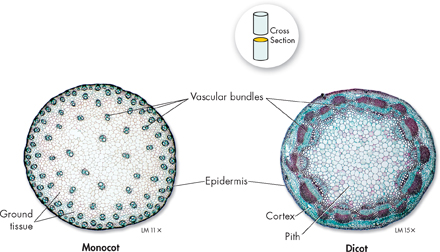Anatomy of a Stem Stems contain the plant's three tissue systems: dermal, vascular, and ground tissue. Stems are surrounded by a layer of epidermal cells that have thick cell walls and a waxy protective coating. Growing stems contain distinct nodes, where leaves are attached, as shown in Figure 23–11. Small buds are found where leaves attach to the nodes. Buds contain apical meristems that can produce new stems and leaves. In larger plants, stems develop woody tissue that helps support leaves and flowers.
Vascular Bundle Patterns The arrangement of tissues in a stem differs among seed plants. In monocots, clusters of xylem and phloem tissue, called vascular bundles, are scattered throughout the stem. In most dicots and gymnosperms, vascular bundles are arranged in a cylinder, or ring. For a comparison of monocot and dicot stems, look at Figure 23–12.

FIGURE 23–11 Anatomy of a Stem Stems produce leaves from their nodes and new branches from buds. They hold leaves up to the sunlight, where they carry out photosynthesis.

FIGURE 23–12 Comparing Monocots and Dicots These cross sections through a monocot and dicot stem show their similarities and differences. Observe How does the arrangement of the vascular bundles differ?
▸ Monocot Stems The cross section of a young monocot stem shows all three tissue systems clearly. The stem has a distinct epidermis, which encloses ground tissue and a series of vascular bundles. In monocots, vascular bundles are scattered throughout the ground tissue. The ground tissue is fairly uniform, consisting mainly of parenchyma cells.
▸ Dicot Stems Young dicot stems have vascular bundles, too, but they are generally arranged in an organized, ringlike pattern. The parenchyma cells inside the ring of vascular tissue are known as pith, while those outside form the cortex of the stem. These relatively simple tissue patterns become more complex as the plant grows larger and the stem increases in diameter.
 In Your Notebook Create a Venn diagram in which to record similarities and differences in the stem structure of monocots and dicots.
In Your Notebook Create a Venn diagram in which to record similarities and differences in the stem structure of monocots and dicots.
Table of Contents
- Formulas and Equations
- Applying Formulas and Equations
- Mean, Median, and Mode
- Estimation
- Using Measurements in Calculations
- Effects of Measurement Errors
- Accuracy
- Precision
- Comparing Accuracy and Precision
- Significant Figures
- Calculating With Significant Figures
- Scientific Notation
- Calculating With Scientific Notation
- Dimensional Analysis
- Applying Dimensional Analysis




